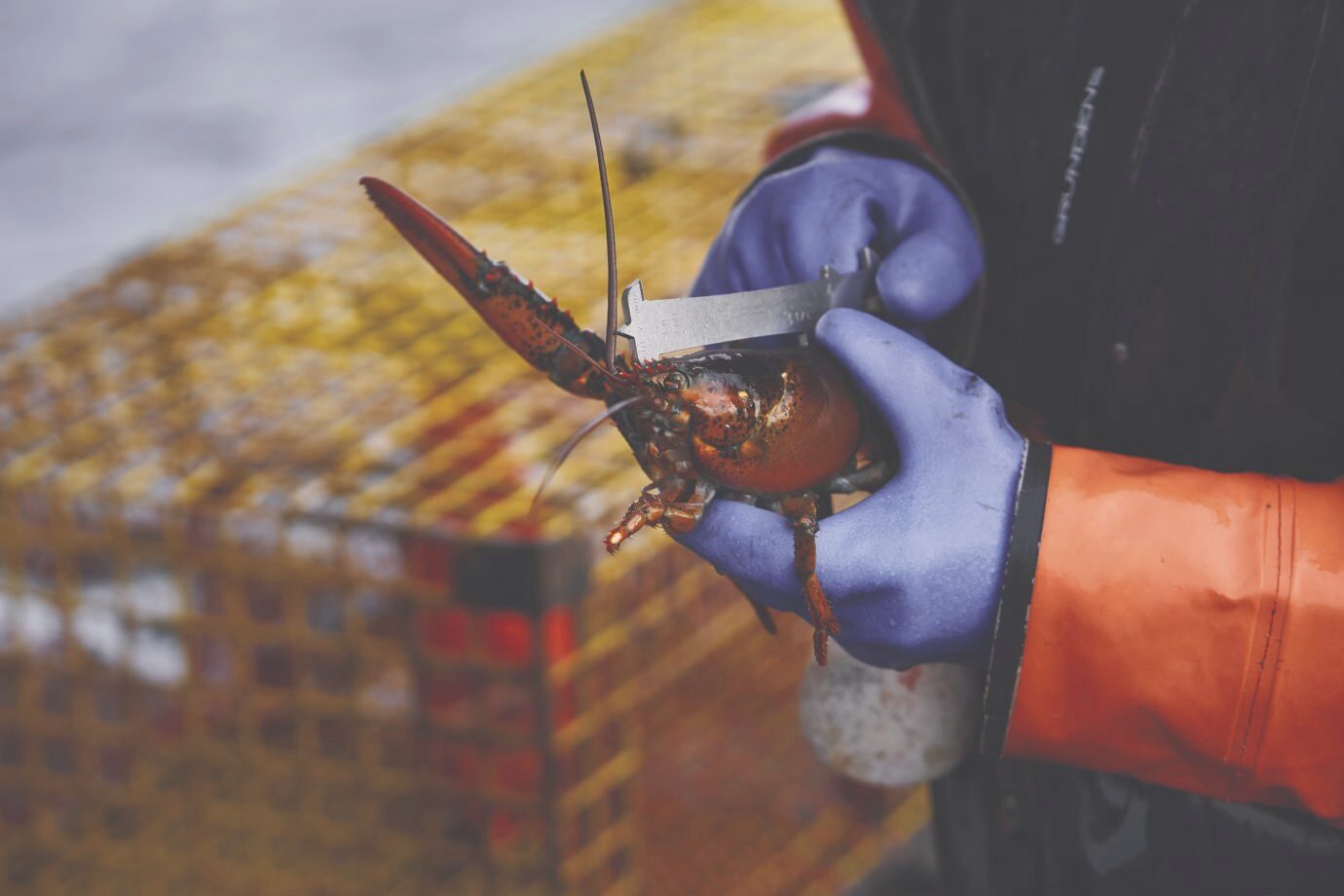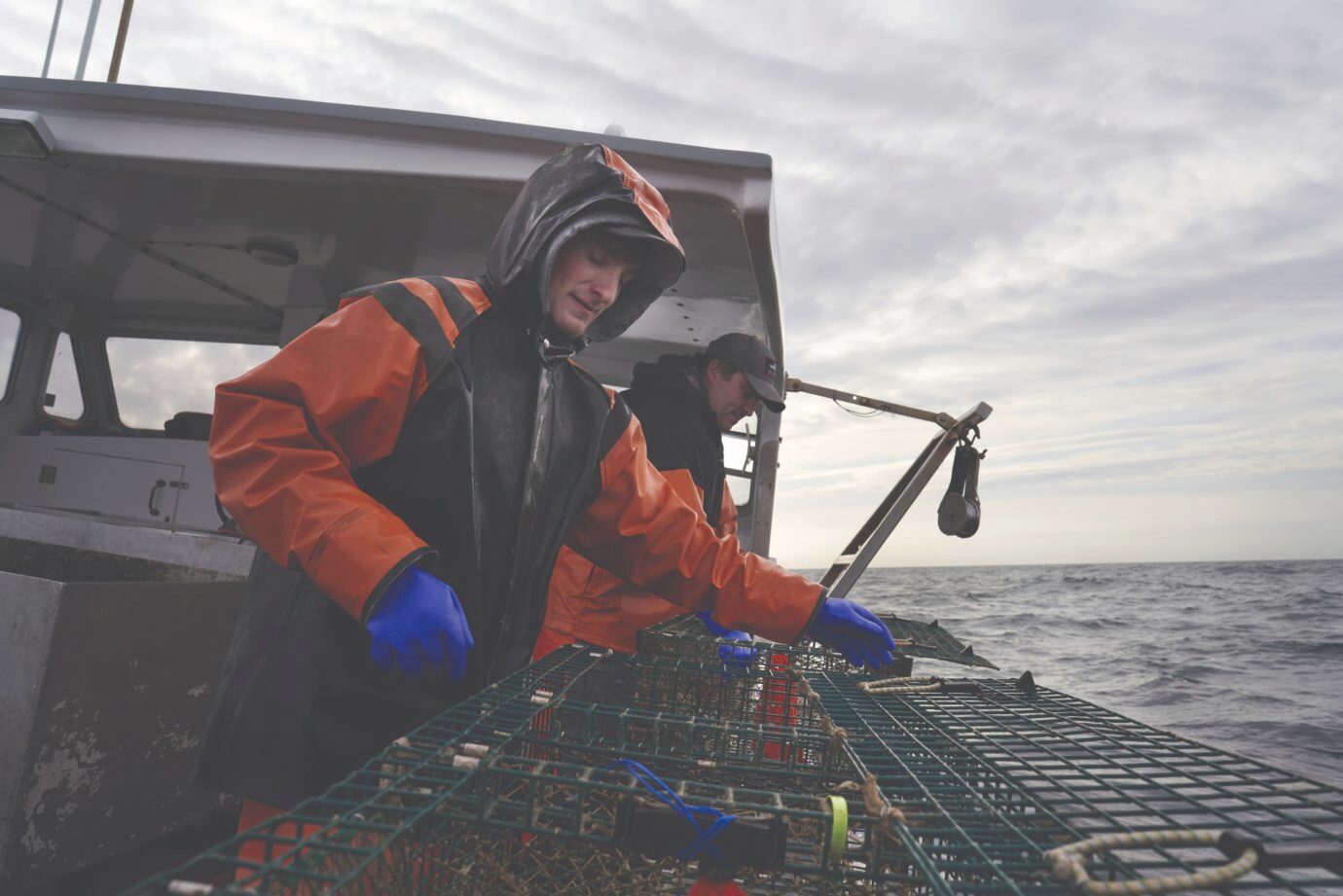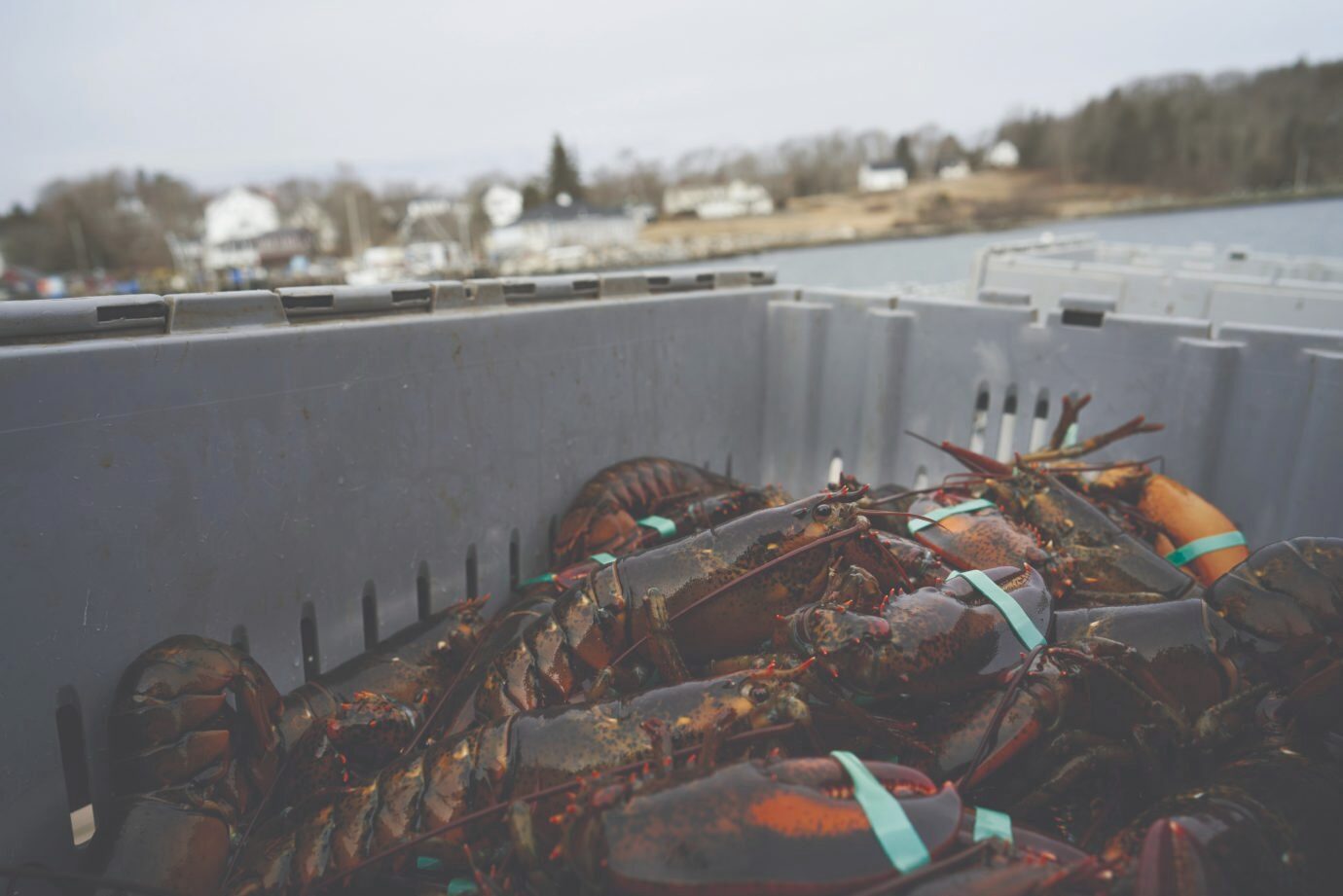Sandwich magazine
A sustainable journey into the world of maine lobster fishing
By hilary nangle
Fifth generation Maine lobsterman Kelly Wallace, 28, is scared.
Not only is the sustainability of Maine’s lobster fishery endangered, so, too, is that of those iconic fishing villages dotting coastal and island harbors. Ask marine research scientists about the sustainability of Maine’s fisheries, especially that of the state’s iconic American lobster, and the responses cover climate change and warming ocean waters. Ask Maine lobstermen (and that term includes women), and the reply is often less about climate and more about preserving community, limiting regulations, sourcing bait, and protecting waterfront access.

photography by: David Degner
LOBSTER 101
Say Maine, and most conjure that calendar-cover image of the granite-girdled coast: A cozy harbor edged with ramshackle fishing wharves topped with lobster traps and bait barrels; lobster boats and colorful buoys bobbing in rippling waters; and spruce-trimmed islands salting the panorama. All that’s missing are a few salty characters with accents thicker than fish chowder.
That’s exactly the view from McLoon’s Lobster, a traditional Maine lobster shack just south of Rockland, in midcoast Maine. Order at the window, settle at a picnic table with friends or family, unload all the go-withs—that includes everything from a tablecloth and flowers to wine and beer—and perhaps watch fishermen unloading their catches while awaiting your lobster. I’ve feasted at such shacks all along the Maine coast. I’m thankful McLoon’s is close enough to home that a few times each summer, I pack a cooler with a bottle or two of prosecco and join friends there to savor a lobster while drinking in the view.
Maine lobster is American lobster or Homarus americanus, a species found from Cape Hatteras, a string of islands off the North Carolina coast in the south, to Labrador, the easternmost Canadian province. According to the Atlantic States Marine Fisheries Commission, the American lobster fishery is the most valuable single-species fishery in the United States. In 2018, more than 147 million pounds of lobster were landed coast wide; Maine accounted for more than 121 million of those.
MAINE LEADS
Maine’s state motto, Dirigo, means “I lead”, and when it comes to conservation, its lobstermen do just that.
Tools they pioneered for protecting the fishery include permits and licenses, lobster size limitations, trap vents allowing smaller lobsters to escape, a biodegradable panel that frees trapped lobsters if trap line is severed, and V-notching shells to protect egg-bearing females.
Maine limits the number of licenses awarded to lobster-fishing boats to 1,793 and the number of traps per boat to 800. “You don’t just get into the lobster fishing industry,” says lobsterman Ryan Post, his voice edged with passion driven by pride, patriotism, and determination. “The first part of sustainability is the families that we are supporting. That’s the foundation and also the heritage. We are the stewards of our resource. We were conservationists before it was cool.”
The Gulf of Maine falls squarely in what Dr. Wahle calls the lobster comfort zone, between Atlantic Canada’s cold waters and southern New England’s warmer waters. After record high lobster landings (catches) in the 1990s, southern New England’s fishery began collapsing due to excessive heat waves and warming waters. The center of gravity shifted northward to the Gulf of Maine, especially the waters around Down East Maine and the Bay of Fundy. The resulting surge in lobster landings elevated Maine’s lobster fishery to its current status as the most valuable in the nation.

photography by: David Degner
“There’s been a six-fold increase from the late 1980s, when I got into the picture, and 2018. It’s been a dramatic change that’s largely temperature related,” Wahle says. But, he adds: “It looks like we’ve hit the crest of this wave.” Maine’s lobster landings dropped 17 percent to 100.7 million pounds in 2019. Although it was the ninth consecutive year breaking the 100 million pound mark, it was the smallest catch since 2010 per the Maine Dept of Marine Resources.
Josh Miller lives in Tenant’s Harbor, a postcard fishing village within the town of St. George, sited two peninsulas east of where I live. The 43-year-old lobsterman comes from a fishing family, and his two teenage daughters have helped haul traps since each turned eight. But Miller, who studied marine biology while in college and is active in collaborative marine research and lobster management, sees evidence of climate change and wonders whether that legacy will continue. “The lobster patterns are different; they don’t act the same as they used to 20 years ago. The patterns that happened every year—when they came in and first shed and went back out; the predictability of the crawl and shed was pretty reliable; you could set your watch within a week or two.” That’s no longer the case.
Lobsterman Connor O’Neil, 26, agrees. “Climate change has completely changed our ecosystem in ways people don’t understand,” says the Colby College graduate who grew up in Freeport, just north of Portland, Maine’s largest city. O’Neil spent much of his youth island-hopping in Casco Bay, later participating in local marine studies. Now one of fewer than 400 year-round residents on North Haven, an island in Penobscot Bay, he takes a studied approach to climate change and sustainability. “Fear clouds people’s minds: ‘If I don’t deal with it, it’s not happening’.” But it is.

photography by: David Degner
Maine lobstermen say enough is enough when it comes to federal regulations designed to protect the critically endangered North Atlantic right whale, which migrates through the Gulf of Maine. Its population has declined nearly 6 percent since January 2017; and 85 percent of the whales show signs of rope entanglement. Environmental groups blame the amount of rope Maine lobstermen use.
In January 2018, environmental conservation groups sued the National Marine Fisheries Service alleging that it’s violating the Endangered Species Act and the Marine Mammal Protection Act. Federal regulators proposed rules requiring Maine to reduce the amount of rope by adding more traps per line.
Not so fast, reply Maine lobstermen. They’ve been making modifications to help protect whales for 10 years and cite only one instance, in 2004, documenting a whale entangled in Maine ropes. Of the 28 North Atlantic right whales found dead since 2014, twenty have been in Canadian waters. Equally important is that, adding more traps per line would make lobster fishing more dangerous than it already is. “Regulations coming from state or national government aren’t the reason Maine’s lobster fishery is sustainable, it’s the fishermen,” lobsterman Post says. “Not one lobsterman on the Maine coast wants to hurt a whale. We’re the stewards of the ocean.”
Patrice McCarron, director of the Maine Lobstermen’s Association, addressed members at their annual meeting in March of 2020 at the oceanfront Samoset Resort in Rockport. Outside the windowless conference room, lobster buoys danced in Penobscot Bay’s tidal waters. Inside, the tide of anger was rising. “We want decisions based on sound science with the best available data. It must be a shared responsibility. Maine will do its part, but why only look at lobster fishing?” She pointed to other types of fishing, other lobster fisheries, and ship strikes. “The reasons why the whales died are not known in 75 percent of the whale deaths. Here’s a bold suggestion: If 75 percent are unknown, let’s look at what is known and not call all unknown [deaths as being] related to lobster fishing.”

photography by: David Degner
SOLASTALGIA
When asked what scares her about the future, Rockport lobsterman Sadie Samuels ticks off climate change, Coronavirus, whale regulations, bait, and fuel prices. “I’m struggling with it—like, I really want fishing to still be around, and I want there to be some sort of way for everyone to work together because things are changing so fast.”
Like many Maine lobstermen, Samuels is the latest in a long line of lobstermen. I met this young woman, whose girl-next-door looks belie her muscled arms, at a weekly farmers’ market where she sold her catch during summer. “What’s special about lobstering is we’re all so connected to our territory; we go back generations tending the same area,” she says.
“The local community is the heart of each area, and with a fishing community, you live or die together."
Many are like Bob Ingalls, of Buck’s Harbor, a fishing village in down east Machiasport. He followed in the boots of his father, grandfather, and great-grandfather; two sons continue the legacy. “Fishing is the lifeblood of coastal towns,” he says.
“It’s embedded in our DNA,” adds Post, a fourth-generation lobsterman from Metinic Island. “It’s not a one-dimensional thing. If you have a year-round residence with 150 people, and you’re not allowed to continue the heritage, it makes you move away; what good is that? Those kids want to stay here. They don’t want to go. They want to take on gramp’s legend.”
Right now, many lobstermen fear losing their community even more than climate change and proposed whale regulations. Encroaching development, the loss of waterfront access, the cost of flood insurance, and being forced off their land by rising values and taxes all threaten their existence.
Monique Coombs of the Maine Coast Fishermen’s Association, describes the stress one feels when their environment is changed, particularly due to climate change or severe storms as Solastalgia. “This term could also be applied to a fisherman who is nostalgic for his community because it has undergone major development and/ or loss of working waterfront,” she says, adding: “It’s a sense of homesickness in a place that’s your home.”

photography by: David Degner
THE FINAL BLOW
In March, Coombs released a report on the state of Maine’s working waterfronts to help inform future steps for their preservation. Her research included interviews with fishermen in coastal communities about the challenges they’re facing.
“Helplessness, chronic pain, fatigue, the sense of not being in control, came up in every single interview,” she says. It’s the nature of an industry that’s dominated by men, physically demanding, insulated, introverted, and high stress. “Just go fishing—that’s how fishermen deal with everything, from breaking a rib, to losing a friend, to going overboard,” she reports. In many coastal communities, lobster is the economic mainstay. “Coastal communities have all their eggs in one basket; they’re perilously dependent on one fishery right now,” Wahle says. “A lot of fishermen were doing quite well for the past couple of decades, when lobster landings were surging, but I really worry, especially about young fishermen who have known nothing else. Many have overinvested in big boats and trucks.” That adds more stress to an already precarious situation.
Now add Covid19, with restaurants, lodgings, and most stores shuttered, borders closed, and people self-isolating or quarantined. The result: An unprecedented drop in demand for lobster, and a palpable fear felt all along Maine’s coast, where fishing and tourism drive the economy. Kelly Wallace worries not only about her future, but also about the sustainability of her tight-knit community in Friendship, a quiet fishing town with about 100 residents at the tip of a peninsula. “So many people here lobster for a living, it’s all they know. Some didn’t graduate high school,” she says.
Like every Maine lobsterman, she wonders what’s next. Will the sixth generation, her 2-year-old son, grow up on the family-owned wharf and in the boat as she did?
“If I ever have to stop lobstering, it’s going to hurt and it’s going to suck. I’ve put so much time, effort and money into this, I hope it turns around and gets better.”
One week later, I messaged Wallace about buying some lobsters for dinner. “We have shut the wharf down,” she replied. “We just have a few fishermen still fishing, and they’re selling their lobsters themselves”
Originally printed in Sandwich Magazine. Copyright © 2020. Purchase your copy here!



